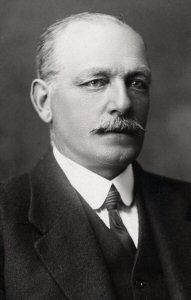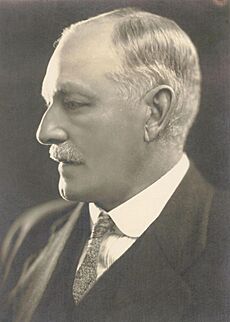John Hayes (Tasmanian politician) facts for kids
Quick facts for kids
John Hayes
|
|
|---|---|
 |
|
| President of the Senate | |
| In office 1 July 1938 – 30 June 1941 |
|
| Preceded by | Patrick Lynch |
| Succeeded by | James Cunningham |
| Senator for Tasmania | |
| In office 12 September 1923 – 30 June 1947 |
|
| Preceded by | Thomas Bakhap |
| Premier of Tasmania | |
| In office 12 August 1922 – 14 August 1923 |
|
| Preceded by | Walter Lee |
| Succeeded by | Walter Lee |
| Member of the Tasmanian House of Assembly | |
| In office 23 January 1913 – 12 September 1923 |
|
| Constituency | Bass |
| Personal details | |
| Born |
John Blyth Hayes
21 April 1868 Bridgewater, Tasmania, Australia |
| Died | 12 July 1956 (aged 88) Launceston, Tasmania, Australia |
| Political party | Liberal (to 1916) Nationalist (1916–31) UAP (1931–45) Liberal (from 1945) |
| Spouse |
Laura Blyth
(m. 1907) |
| Relations | Ernest Blyth (brother-in-law) |
| Occupation | Farmer |
John Blyth Hayes (21 April 1868 – 12 July 1956) was an important Australian politician. He was a Senator for Tasmania from 1923 to 1947. He also served as the President of the Senate from 1938 to 1941. Before working in federal politics, he was a member of the Parliament of Tasmania from 1913 to 1923. He even served as the Premier of Tasmania for about a year, from 1922 to 1923.
Contents
Early Life and Career
John Hayes was born on 21 April 1868 in Bridgewater, Tasmania. His father, Joshua John Hayes, was a farmer. John's grandfather, John Hayes, was also a politician in Tasmania.
John was taught by his mother when he was young. Later, he joined the Western Australian gold rushes. He became a manager at a special factory that processed ore and used chemicals to get gold. Around 1906, he moved back to Tasmania. He bought a farm in Scottsdale. In 1907, he married his cousin, Laura Linda Blyth. Her brother, Ernest Blyth, also became a politician.
Starting in State Politics
John Hayes became involved in community groups. In 1911, he was chosen as president of a farming association. In 1912, he became secretary of the Scottsdale Board of Agriculture.
In 1913, Hayes was elected to the Tasmanian House of Assembly. This is like the state parliament in Tasmania. He ran as a Liberal politician in the area called Bass. Farmers in the area supported him.
In 1915, he became the deputy leader of the opposition party. After the 1916 state election, his party formed the government. They then changed their name to the Nationalist Party.
Roles in Government
With Walter Lee as the Premier, John Hayes held several important jobs. From 1916 to 1919, he was the Minister for Lands and Works. He was also the Minister for Works from 1919 to 1923. At the same time, he was the Minister for Agriculture from 1916 to 1923. He was also in charge of the Hydro-Electric Department, which manages electricity from water.
People praised him for his work in agriculture. He also helped with a program called soldier settlement. This program helped soldiers who returned from war get land to farm. In 1921, he received an award called the Companion of the Order of St Michael and St George (CMG). This award recognizes important service.
In 1922, his party lost some power in the state election. A new party, the Tasmanian Country Party, gained many seats. This party was led by John's brother-in-law, Ernest Blyth. The Premier, Walter Lee, resigned.
On 14 August 1922, John Hayes became the new Premier of Tasmania. He formed a special government called a "coalition" with the Country Party. This was the first time such a government was formed in Tasmania. The government had a lot of debt. John Hayes tried to fix the money problems but found it very difficult. He resigned as Premier on 16 August 1923, after just over a year in the job.
Moving to Federal Politics
After leaving the Premier role, John Hayes decided to run for a seat in the Australian Parliament. He wanted to fill a vacant Senator position for Tasmania. He won the election by a small number of votes. He started his term as a Senator on 12 September 1923.
He was re-elected several times, serving full six-year terms. In 1931, his party joined with others to form the United Australia Party (UAP).
President of the Senate
As a Senator, John Hayes focused on issues important to farmers and to Tasmania. He was part of a special committee that looked at public money from 1926 to 1932. He even led this committee for a while.
On 1 July 1938, he was elected President of the Senate. This was a big achievement, as he was the first person from Tasmania to hold this important position. At that time, all three top political jobs in Australia were held by Tasmanians: the President of the Senate (John Hayes), the Speaker of the House of Representatives, and the Prime Minister.
When he first became President, some Senators disagreed with his decisions. However, over time, his rulings were widely accepted. He lost his position in an unusual way on 1 July 1941. The Senate had a new election, and the government's party had a small majority. But two of their Senators were not there. This meant that the opposing party's candidate, James Cunningham, tied with Hayes. To decide who would be President, they drew names from a hat, and Cunningham's name was chosen.
Later Years
John Hayes did not run for re-election in 1946. His term as Senator ended on 30 June 1947, when he was 79 years old. He retired to Launceston. He passed away on 12 July 1956. He was given a state funeral, which is a special ceremony for important public figures. He was buried at Carr Villa Cemetery.




